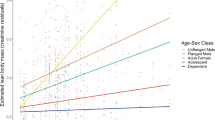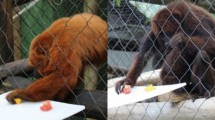Abstract
I used novel quantitative measures to assess the impact of fruit seasonality on changes in diet and energy balance during 4918 hours of observation on <60 orangutans in Gunung Palung National Park, West Kalimantan, Indonesia, from September 1994 through September 1995. During this period a mast fruiting occurred, resulting in large fluctuations in fruit availability, measured by monitoring of 558 orangutan fruit trees. Orangutan diet varied tremendously in accordance with these fluctuations. During the month of highest fruit production, 100% of the orangutan diet was composed of fruit. In contrast, during the fruit-poor period as little as 21% of the diet was fruit, while 37% was bark. Nutritional analyses of 78 of the foods most commonly eaten during this study show that mast foods were significantly higher in caloric content than were nonmast foods, which translates into substantial changes in caloric intake. During the month of highest fruit consumption (January), males consumed an estimated 8422 kcal/day and females consumed 7404 kcal/day. During the month of lowest fruit consumption (May), males consumed 3824 kcal/day and females consumed 1793 kcal/day. These differences were significantly different between the 2 months for both males and females. In May, males ate significantly more kcal/day than females did. Time spent feeding did not differ between the two periods for either males or females. I assessed the impact of these changes in diet and caloric intake on orangutan physiological functioning by measuring ketones in 257 urine samples collected from adult males and females. Ketones—products of fat metabolism—were present in urine only during the fruit-poor period. These data suggest that orangutans are highly efficient at storing fat during fruit-rich periods and utilizing the reserves during times of fruit shortfall. This response may have important implications for orangutan survivorship, reproduction, and behavior.
Similar content being viewed by others
REFERENCES
American Dietetic Association (ADA) (1992). Manual of Clinical Dietetics, American Dietetic Association, Chicago.
Appanah, S. (1981). Pollination in Malaysian primary forests. Malay. For. 44: 37–42.
Altmann, J., Schoeller, D., Altmann, S. A., Muruthi, P., and Sapolsky, R. M. (1993). Body size and fatness of free-living baboons reflect food availability and activity levels. Am. J. Primatol. 30: 149–161.
Ashton, P. S., Givinish, T. J., and Appanah, S. (1988). Staggered flowering in the Dipterocarpaceae: New insights into floral induction and the evolution of mast fruiting. Am. Nat. 132: 44–66.
Association of Official Analystical Chemists (AOAC) (1984). Fat (crude) or ether extract in animal feeds: direct method. In Williams, S. (ed.), Official Methods of Analysis of the Association of Official Analytical Chemists, Association of Official Analytical Chemists, Arlington, VA, pp. 159–160.
Curran, L. M., Leighton, M., and Nirarita, C. E. (1998). Temporal and spatial distribution of fruitfall in mast-fruiting Bornean Dipterocarpaceae 1986–96. I. Optimal germination, increased seed size and resource accumulation hypotheses. J. Ecol. (in review).
Ellison, P. T., Panter-Brick, C., Lipson, S. F., and O'Rourke, M. T. (1993). The ecological context of human ovarian function. Hum. Reprod. 8: 2248–2258.
Fischbach, F. A. (1988). Manual of Laboratory Diagnostic Tests, J. B. Lippincott, New York.
Galdikas, B. (1988). Orangutan diet, range, and activity at Tanjung Puting, Central Borneo. Int. J. Primatol. 9: 1–35.
Galdikas, B., and Wood, J. W., (1990). Birth spacing patterns in humans and apes. Am. J. Phys. Anthropol. 83: 185–191.
Goering, H. K., and Van Soest, P. J. (1970). Forage fiber analysis. In Agricultural Handbook No. 379, ARS, USDA, Washington, DC.
Goodall, J. (1986). The Chimpanzees of Gombe: Patterns of Behavior, Harvard University Press, Cambridge, MA.
Knott, C. (1996). Monitoring health status of wild orangutans through field analysis of urine. Am. J. Phys. Anthropol. Suppl. 22: 139–140.
Knott, C. (1997). Field collection and preservation of urine in orangutans and chimpanzees. Trop. Biodiv. 4: 95–102.
Knott, C. D. (1998). Social system dynamics, ranging patterns and male and female strategies in wild Bornean orangutans (Pongo pgymaeus). Am. J. Phys. Anthropol. Suppl. 26: 140.
Leighton, M. (1993). Modeling diet selectivity by Bornean orangutans: Evidence for integration of multiple criteria for fruit selection. Int. J. Primatol. 14: 257–313.
Leighton, M., and Leighton, D. (1983). Vertebrate responses to fruiting seasonality within a Bornean rain forest. In Sutton, S. L., Whitmore, T. C., and Chadwick, A. C. (eds.), Tropical Rain Forest: Ecology and Management, Blackwell Scientific, Boston. pp. 181–196.
MacKinnon, J. (1971). The orangutan in Sabah today. Oryx 11: 141–191.
MacKinnon, J. R. (1974). The behaviour and ecology of wild orang-utans (Pongo pygmaeus). Anim. Behav. 22: 3–74.
Medway, L. (1972). Phenology of a tropical rain forest in Malaya. Biol. J. Linn. Soc. 4: 117–146.
Milton, K., and Demment, M. W. (1988). Digestion and passage kinetics of chimpanzees fed high and low fiber diets and comparison with human diet. J. Nutr. 118: 1082–1088.
Mitani, J. C. (1989). Orangutan activity budgets: Monthly variations and effect of body size, parturition, and sociality. Am. J. Primatol. 18: 87–100.
Mori, A. (1979). Analysis of population changes by measurement of body weight in the Koshima troop of Japanese monkeys. Primates 20: 371–397.
National Academy of Science (NRC) (1980). Recommended Dietary Allowances, National Academy of Sciences, Washington, DC.
Pierce, W. C., and Haenisch, E. L. (1947). Quantitative Analysis, John Wiley & Sons, London.
Robertson, J. B., and van Soest, P. J. (1980). The detergent system of analysis and its application to humans foods. In James, W. P. T., and Theander, O. (eds.), The Analysis of Dietary Fiber in Food, Marcel Dekker, New York.
Robinson, A. M. (1980). Physiological role of ketone bodies as substrates and signals in mammalian tissues. Physiol. Rev. 60: 143.
Rodman, P. S. (1977). Feeding behavior of orangutans in the Kutai Reserve, East Kalimantan. In Clutton-Brock, T. H. (ed.), Primate Ecology, Academic Press, London, pp. 383–413.
Rodman, P. S. (1979). Individual activity profiles and the solitary nature of orangutans. In Hamburg, D. L., and McDown, E. R. (eds.), The Great Apes, W. A. Benjamin, London, pp. 234–255.
Rodman, P. S. (1984). Foraging and social systems of orangutans and chimpanzees. In Rodman, P. S., and Cant, J. G. H. (eds.), Adaptations for Foraging in Nonhuman Primates, Columbia University Press, New York, pp. 134–160.
Sokal, R. R., and Rohlf, J. F. (1981). Biometry, W. H. Freeman, New York.
van Schaik, C. P. (1986). Phenological changes in a Sumatran rainforest. J. Trop. Ecol. 2: 327–347.
van Schaik, C. P., and Fox, E. A. (1996). Manufacture and use of tools in wild Sumatran orangutans. Naturwissenschaften 83: 186–188.
van Schaik, C. P., and Van Noordwijk, M. A. (1985). Interannual variability in fruit abundance and the reproductive seasonality in Sumatran long-tailed macaques (Macaca fascicularis). J. Zool., Lond. A. 206: 533–549.
Watson, J., and Jaffe, M. S. (1995). Nurse's Manual of Laboratory and Clinical Diagnostic Tests, F. A. Davis, Philadelphia.
Wheatley, B. P. (1982). Energetics of foraging in Macaca fascicularis and Pongo pygmaeus and a selective advantage of large body size in the orang-utan. Primates 23: 348–363.
Wheatley, B. P. (1987). The evolution of large body size in orangutans: A model for hominoid divergence. Am. J. Primatol. 13: 313.
Whitmore, T. C. (1986). Tropical Rain Forests of the Far East, Oxford University Press, Oxford.
Author information
Authors and Affiliations
Rights and permissions
About this article
Cite this article
Knott, C.D. Changes in Orangutan Caloric Intake, Energy Balance, and Ketones in Response to Fluctuating Fruit Availability. International Journal of Primatology 19, 1061–1079 (1998). https://doi.org/10.1023/A:1020330404983
Issue Date:
DOI: https://doi.org/10.1023/A:1020330404983




